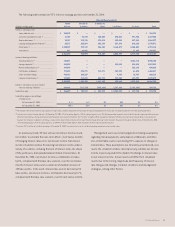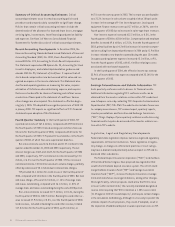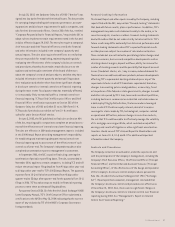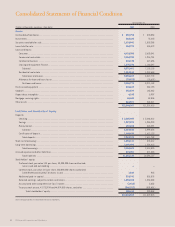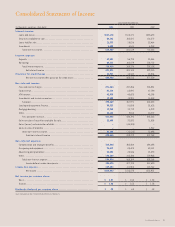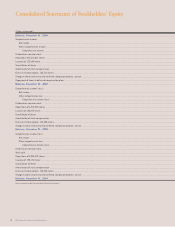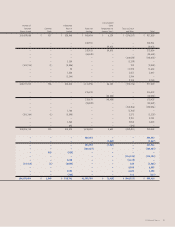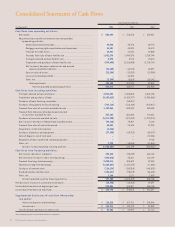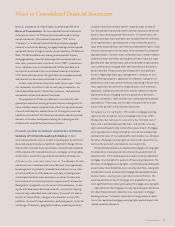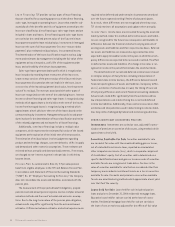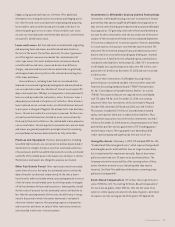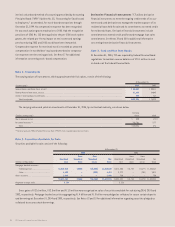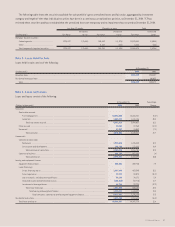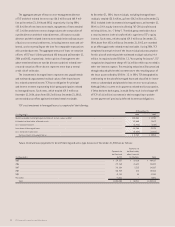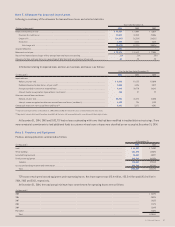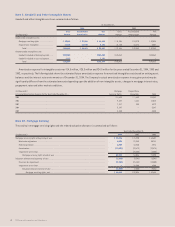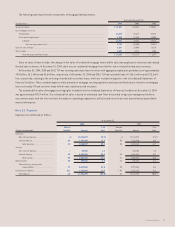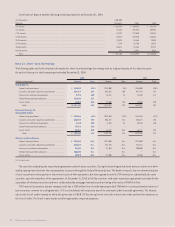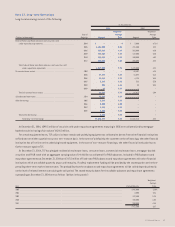TCF Bank 2004 Annual Report Download - page 57
Download and view the complete annual report
Please find page 57 of the 2004 TCF Bank annual report below. You can navigate through the pages in the report by either clicking on the pages listed below, or by using the keyword search tool below to find specific information within the annual report.
2004 Annual Report 55
hedges using quoted market prices. See Note 19 for additional
information concerning derivative instruments and hedging activi-
ties. Net fees and costs associated with originating and acquiring
loans held for sale are deferred and are included in the basis for
determining the gain or loss on sales of loans held for sale. Gains
on sales are recorded at the settlement date and cost is determined
on a specific identification basis.
Loans and Leases Net fees and costs associated with originating
and acquiring loans and leases are deferred and amortized over
the lives of the assets. The net fees and costs for sales-type leases
are offset against revenues recorded at the commencement of
sales-type leases. Discounts and premiums on loans purchased,
net deferred fees and costs, unearned discounts and finance
charges, and unearned lease income are amortized using methods
which approximate a level yield over the estimated remaining lives
of the loans and leases.
Loans and leases, including loans that are considered to be
impaired, are reviewed regularly by management and are placed on
non-accrual status when the collection of interest or principal is 90
days or more past due (150 days or six payments or more past due for
loans secured by residential real estate), unless the loan or lease is
adequately secured and in the process of collection. When a loan or
lease is placed on non-accrual status, uncollected interest accrued
in prior years is charged off against the allowance for loan and lease
losses. Interest accrued in the current year is reversed. For those non-
accrual leases that have been funded on a non-recourse basis by
third-party financial institutions, the related debt is also placed on
non-accrual status. Interest payments received on non-accrual loans
and leases are generally applied to principal unless the remaining
principal balance has been determined to be fully collectible.
Premises and Equipment Premises and equipment, including
leasehold improvements, are carried at cost and are depreciated or
amortized on a straight-line basis over their estimated useful lives
of owned assets and for leasehold improvements over the estimated
useful life of the related asset or the lease term, whichever is shorter.
Maintenance and repairs are charged to expense as incurred.
Other Real Estate Owned Other real estate owned is recorded
at the lower of cost or fair value less estimated costs to sell at the
date of transfer to other real estate owned. At the time a loan is
transferred to other real estate owned, any carrying amount in excess
of the fair value less estimated costs to sell the property is charged
off to the allowance for loan and lease losses. Subsequently, should
the fair value of an asset less the estimated costs to sell decline to
less than the carrying amount of the asset, the deficiency is recog-
nized in the period in which it becomes known and is included in
other non-interest expense. Net operating expenses of properties
and recoveries and losses on sales of other real estate owned are
also recorded in other non-interest expense.
Investments in Affordable Housing Limited Partnerships
Investments in affordable housing consist of investments in limited
partnerships that operate qualified affordable housing projects or
that invest in other limited partnerships formed to operate affordable
housing projects. TCF generally utilizes the effective yield method to
account for these investments with the tax credits net of the amor-
tization of the investment reflected in the Consolidated Statements
of Income as a reduction of income tax expense. However, depending
on circumstances, the equity or cost methods may be utilized. The
amount of the investment along with any unfunded equity contri-
butions which are unconditional and legally binding are recorded
in other assets. A liability for the unfunded equity contributions is
recorded in other liabilities. At December 31, 2004, TCF’s investments
in affordable housing limited partnerships were $49 million, com-
pared with $41.8 million at December 31, 2003 and were recorded
in other assets.
Four of these investments in affordable housing limited
partnerships are considered variable interest entities under the
Financial Accounting Standards Board (“FASB”) Interpretation
No. 46, “Consolidation of Variable Interest Entities” as revised
(FIN 46). These partnerships are not required to be consolidated
with TCF under FIN 46. As of December 31, 2004, the carrying
amount of these four investments, which were made in May and
October 2002, November 2003 and July 2004, was $46.7 million.
This amount included $13.9 million of unconditional unfunded
equity contributions which are recorded in other liabilities. Thus,
the maximum exposure to loss on these four investments was $46.7
million at December 31, 2004; however, the general partner of these
partnerships provides various guarantees to TCF including guaran-
teed minimum returns. These guarantees are backed by a AAA
credit-rated company and significantly limit any risk of loss.
Intangible Assets On January 1, 2002, TCF adopted SFAS No.142,
“Goodwill and Other Intangible Assets,” which requires that goodwill
and intangible assets with indefinite lives no longer be amortized,
but instead tested for impairment annually. Deposit base intan-
gibles are amortized over 10 years on an accelerated basis. The
Company reviews the recoverability of the carrying values of these
assets whenever an event occurs indicating that they may be
impaired. See Note 9 for additional information concerning intan-
gible assets and goodwill.
Stock-Based Compensation TCF utilizes the recognition provi-
sions of SFAS No. 123, “Accounting for Stock-Based Compensation,”
for stock-based grants. Under SFAS No. 123, the fair value of an
option or similar equity instrument on the date of grant is amortized
to expense over the vesting period of the grant. TCF applied the


